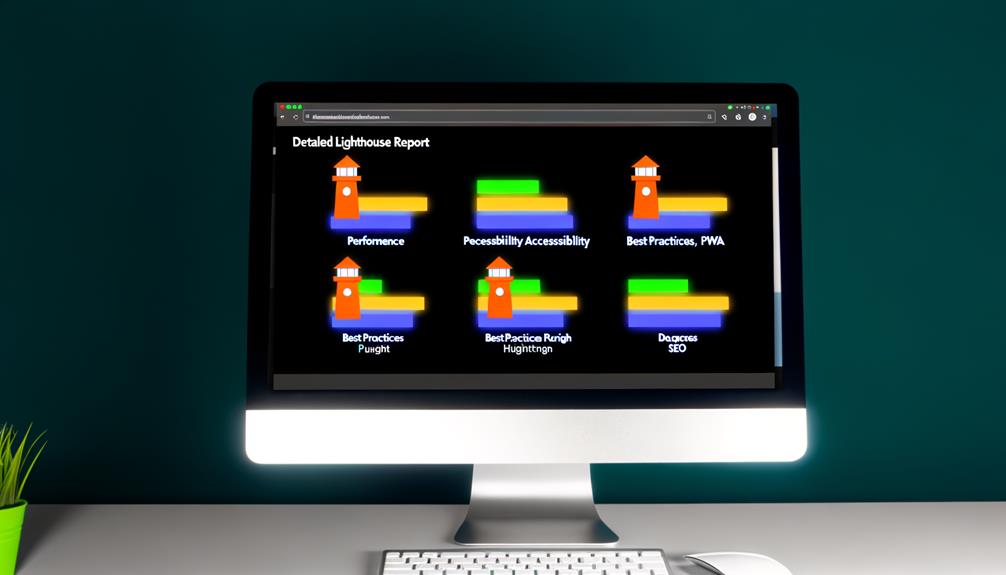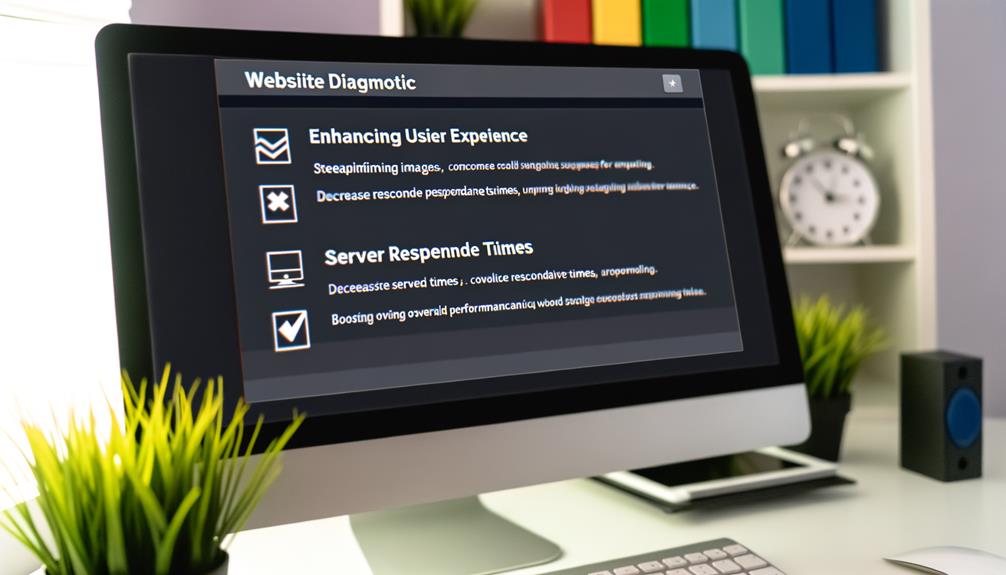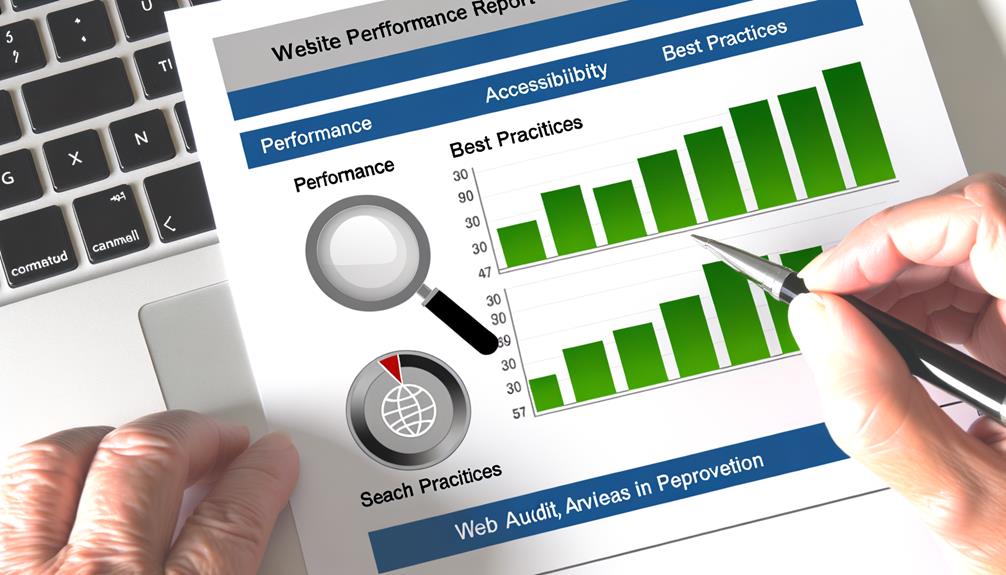As web developers and digital marketers, we are constantly seeking ways to enhance the user experience of our websites.
Google Lighthouse offers a powerful solution for achieving this goal. This tool provides a comprehensive evaluation of web pages, focusing on performance, accessibility, best practices, SEO, and Progressive Web Application qualification.
By harnessing the insights provided by Google Lighthouse, we can make informed decisions that lead to improved organic search rankings, higher conversion rates, and an overall better user experience.
But how exactly does Google Lighthouse achieve these results, and what specific steps can we take to maximize its impact on website UX?
Google Lighthouse Overview

Google Lighthouse is an indispensable tool for evaluating the quality and user experience of web pages, providing comprehensive insights into performance, accessibility, best practices, SEO, and Progressive Web Application qualification.
It offers a holistic view of a website's performance, identifying areas for improvement. Lighthouse assesses key metrics such as First Contentful Paint, Time to Interactive, Total Blocking Time, Speed Index, and Largest Contentful Paint to gauge performance.
It also evaluates accessibility, best practices, SEO, and Progressive Web App standards, ensuring a well-rounded assessment. With its traffic light system, Lighthouse provides clear and actionable feedback, empowering website owners to enhance user experience and site quality.
Using Google Lighthouse
Starting with a pivot from the previous subtopic, our focus now shifts to understanding the practical application of Google Lighthouse for assessing website performance and user experience.
- Ease of Use
- Google Chrome extension simplifies accessibility.
- Chrome DevTools integration for advanced users.
- Reports provide actionable insights for immediate improvements.
- Performance Insights
- Detailed metrics such as First Contentful Paint and Total Blocking Time.
- Simulated mobile device assessment for real-world performance.
- Recommendations tailored to enhance website speed and responsiveness.
- Comprehensive Evaluation
- Scores across Accessibility, Best Practices, SEO, and Progressive Web Application.
- Holistic approach to ensure a well-rounded user experience.
- Actionable recommendations for optimization and compliance.
Metrics Analyzed by Lighthouse

The metrics analyzed by Lighthouse offer a comprehensive evaluation of a website's performance and user experience. They encompass key areas such as speed, accessibility, best practices, SEO, and progressive web application functionality.
Lighthouse assesses performance through metrics like First Contentful Paint, Time to Interactive, Total Blocking Time, Speed Index, and Largest Contentful Paint. These metrics provide insights into the speed and responsiveness of a website.
Accessibility is another important aspect that Lighthouse measures to ensure usability by people of all abilities. It evaluates if a website meets the necessary standards for accessibility.
Best practices are also evaluated by Lighthouse. This includes assessing security measures, adherence to HTML specifications, and error logging. By evaluating these best practices, Lighthouse helps identify areas that can be improved for better website performance.
The SEO score provided by Lighthouse evaluates how well a website adheres to best practices for search ranking improvement. This metric helps website owners optimize their web pages for better visibility in search engine results.
Additionally, Lighthouse tests if a website meets the standards for a Progressive Web Application (PWA). This focuses on performance and responsiveness, ensuring that a website functions like a native app on different devices.
Performance Assessment in Lighthouse
The comprehensive evaluation of a website's performance and user experience, particularly in the area of speed, has become increasingly crucial for enhancing overall UX and optimizing website functionality. In Google Lighthouse, the Performance assessment delves deep into the speed and responsiveness of a website, providing valuable insights to enhance user experience.
This assessment includes:
- Six Performance Metrics: First Contentful Paint, Time to Interactive, Total Blocking Time, Speed Index, Largest Contentful Paint, and Cumulative Layout Shift. These metrics measure factors such as content rendering time, page interactivity, and visual element loading.
- Mobile Device Simulation: Lighthouse simulates page load on a mobile device to ensure a comprehensive performance evaluation. This accounts for variations in internet connections and devices.
- Optimization Recommendations: Lighthouse provides actionable recommendations to improve website speed and performance, ultimately enhancing user experience and satisfaction.
Accessibility and Best Practices

Accessibility and best practices audits play a crucial role in ensuring the usability and adherence to industry standards for web development.
In Google Lighthouse, accessibility is assessed to ensure websites are usable by individuals of all abilities. It checks for semantically-rich HTML tags and alternative text to provide a fully accessible website, with a rating of 100 indicating full accessibility.
Additionally, best practices are evaluated, including security-related measures like HTTPS usage and safe outbound links, as well as HTML doctype specification and appropriate image resolution. The Best Practices score reflects adherence to these practices, while the SEO score assesses adherence to SEO best practices for search ranking improvement.
Furthermore, Lighthouse tests if a website meets the standards for a Progressive Web Application, ensuring an enhanced user experience across devices and locations.
SEO and Progressive Web App Evaluation
An essential aspect of website evaluation involves analyzing the adherence to SEO best practices and determining if the site meets the standards for a Progressive Web Application.
- SEO Evaluation:
- Checks for crawlability and valid HTML tags and attributes.
- Provides quick wins for search ranking improvement.
- Rare low scores due to fundamental nature of the tests.
- Progressive Web App Assessment:
- Measures performance and responsiveness for enhanced user experience.
- Indicates pass or fail for meeting PWA standards.
- Enables easy access and usage across devices and locations.
Analyzing SEO and Progressive Web App compliance is crucial for maximizing organic search rankings and ensuring a seamless user experience. By evaluating these aspects, websites can enhance their visibility and deliver a more responsive and accessible interface for all users.
Implementing Lighthouse Recommendations

Implementing Lighthouse recommendations periodically ensures ongoing optimization of website performance and user experience. By addressing the specific suggestions provided by Lighthouse, website owners can continuously enhance the speed, accessibility, best practices, SEO, and progressive web app aspects of their sites.
Regularly implementing these recommendations helps in maintaining a competitive edge in the digital landscape and meeting evolving user expectations. It's crucial to prioritize and act upon the recommendations that have the most significant impact on the overall user experience and website performance.
This iterative approach not only improves the current state of the website but also ensures that it remains aligned with best practices and industry standards. Incorporating Lighthouse recommendations into regular website maintenance efforts is key to achieving and sustaining an exceptional user experience.
Frequently Asked Questions
How Does Google Lighthouse Impact Website Loading Speed and Performance?
Google Lighthouse significantly impacts website loading speed and performance. It assesses six key metrics, including First Contentful Paint, Time to Interactive, and Total Blocking Time, providing detailed insights into page speed.
By simulating mobile device load times, Lighthouse offers a comprehensive performance evaluation. Its recommendations aid in optimizing speed, enhancing user experience, and positively influencing search rankings and conversion rates.
It's a crucial tool for improving website performance and loading speed.
Can Google Lighthouse Detect and Assess the Usability of Web Applications?
Yes, Google Lighthouse can detect and assess the usability of web applications. It evaluates the quality and user experience of web pages, including web applications.
Lighthouse provides quality scores across five categories, one of which is Accessibility, ensuring that websites are usable by people of all abilities.
It also provides recommendations to help make improvements in usability, ultimately enhancing the overall user experience of web applications.
What Are the Most Common Issues That Google Lighthouse Identifies in Terms of Website Accessibility?
In terms of website accessibility, Google Lighthouse commonly identifies issues related to:
- Proper alternative text for images
- Semantic HTML structure
- Keyboard navigation
These aspects are crucial for ensuring that websites are usable by individuals with diverse abilities.
Lighthouse provides detailed audits and specific recommendations to address these accessibility concerns, allowing website owners to enhance the inclusivity and usability of their web pages.
How Does Google Lighthouse Evaluate a Website's Adherence to SEO Best Practices?
Google Lighthouse evaluates a website's adherence to SEO best practices by conducting tests to check if the page is crawlable, uses valid HTML tags and attributes, and follows SEO guidelines.
The SEO score reflects the compliance with these practices and provides quick wins for search ranking improvement.
Lighthouse's SEO report highlights areas for enhancement and is instrumental in optimizing a website's performance in search engine results.
Can Google Lighthouse Help in Identifying and Fixing Security-Related Issues on a Website?
Yes, Google Lighthouse can help identify and fix security-related issues on a website. It conducts a brief audit of widely accepted web development best practices, including security-related practices like using HTTPS and safe outbound links.
The Best Practices score reflects adherence to these practices, and errors logged to the console may require assistance from a web developer to resolve.
Lighthouse provides valuable insights to enhance website security and user experience.
Conclusion
In conclusion, Google Lighthouse is a powerful tool for web developers and digital marketers to assess and improve the user experience of websites.
By analyzing key metrics such as performance, accessibility, best practices, SEO, and Progressive Web Application qualification, Lighthouse provides valuable insights. These insights can lead to enhanced organic search rankings, improved conversion rates, and an overall better user experience.
Implementing Lighthouse recommendations can drive significant improvements in website UX, making it an essential tool for online platforms.






